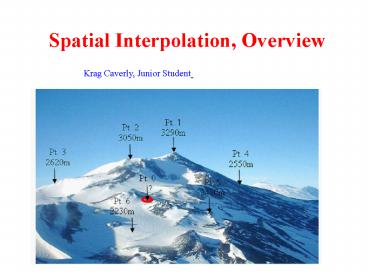Spatial Interpolation, Overview - PowerPoint PPT Presentation
1 / 22
Title:
Spatial Interpolation, Overview
Description:
The Inverse Distance Weighted (IDW) interpolation assumes that each point has a ... triangle can be computed from the length of the edges using Heron's formula: ... – PowerPoint PPT presentation
Number of Views:98
Avg rating:3.0/5.0
Title: Spatial Interpolation, Overview
1
Spatial Interpolation, Overview
Krag Caverly, Junior Student
2
(No Transcript)
3
Spatial Interpolation
Interpolation is the procedure of predicting the
value of an attribute at unsampled site from the
measurements made at point locations within the
same area or region.
4
Principle of Spatial Interpolation
Data close together in space (e.g. elevations)
or time (e.g. temperatures) are likely to be
correlated (related). Many interpolation
procedures and methods are being used in
different fields of science. These methods can
be classified into a few categories.
5
Global/Local Interpolations
- Global
- global interpolators determine a single function
which is mapped across the whole region - a change in one input value affects the entire
map - Local
- local interpolators apply an algorithm repeatedly
to a small portion of the total set of points - a change in an input value only affects the
result within the window
6
Exact/Approximate Interpolations
- Exact
- exact interpolators honor the data points upon
which the interpolation is based. the surface
passes through all points whose values are known - Approximate
- used when there is some uncertainty about the
given surface values - this utilizes the belief that in many data sets
there are global trends, which vary slowly,
overlain by local fluctuations, which vary
rapidly and produce uncertainty (error) in the
recorded values - the effect of smoothing will reduce the effects
of errors in the surface
7
Stochastic/Deterministic Interpolations
- Stochastic / statistical
- stochastic methods incorporate the concept of
randomness - the interpolated surface is conceptualized as one
of many that might have been observed, all of
which could have produced the known data points - Deterministic
- deterministic methods do not use probability
theory
8
Statistical prediction
- The sample mean (expectation) is
- The Standard Deviation is (How far away are the
values from the mean value?
9
Gradual/Abrupt Interpolations
- Gradual
- a typical example of a gradual interpolator is
the distance weighted moving average - Abrupt
- it may be necessary to include barriers in the
interpolation process
10
Spatial InterpolationLocal Interpolation
Voronoi diagram (nearest neighbor)
11
Spatial InterpolationLocal Interpolation
TIN linear interpolation
12
Spatial InterpolationDeterministic interpolation
Inverse Distance Weighted
13
Spatial InterpolationGeostatistical Interpolation
Kriging
14
Spatial InterpolationCombined methods
Topogrid IDW with smoothing
15
Inverse Distance Interpolation
- The Inverse Distance Weighted (IDW) interpolation
assumes that each point has a local influence
that diminishes with distance. - Procedure
- Compute distances to all the points in the
dataset - Compute the weight of each point.
- Weighting function is the inverse power of the
distance. - 3. Compute the weighted average
16
Inverse Distance Interpolationexample
Use inverse distance interpolation to calculate
point 0
17
Inverse Distance Interpolationexample
- Sum of ? 1
- ?4 is the highest
- ?6 is the lowest
18
Inverse Distance Interpolationexample
19
Linear interpolation using TIN
- We want to compute the value Zp at point P inside
a triangle, using the three surrounding points
P1,P2,P3 with the values Z1 ,Z2, Z3 respectively.
- Zp ?1?Z1 ? 2?Z2 ? 3?Z3
- The unique weights ? 1, ? 2, ? 3 are called the
convex coordinates (or barycentric coordinates)
of P and can be computed using various methods
20
TIN for linear interpolation
- Zp ? 1?Z1 ? 2?Z2 ? 3?Z3
- ? 1Area(?PP2P3)/Area (?P 1P 2P 3),
- ? 2Area(?P1PP3)/Area (?P 1P 2P 3),
- ? 3Area(?P1P2P)/Area (?P 1P 2P 3).
- The area of the triangle can be computed from the
length of the edges using Heron's formula - when s (abc)/2 or
p2
21
TIN for linear interpolation
- Area (? P 1P 2P 4) 1175.00
- Area (? P2P0P1) 725.00
- Area (? P 1P 0P 4) 400.00
- Area (? P 2P 0P 4) 50.00
? 1 Area(? P2P0P1)/Area (?P 1P 2P 4)
0.617 ? 2 0.34 ? 3 0.042 ZP
0.617110.5 0.34123.1 0.042115.4 114.94 m
22
Interpolation methods summary
- There is no 'best' interpolation algorithm that
is clearly superior to all others and appropriate
for all applications. - The quality of the resulting surface is
determined by the distribution and accuracy of
the original data points, and the adequacy of the
underlying interpolation model - The most important criterion for selecting an
interpolation method are the degree to which - structural features can be taken into account,
and - the interpolation function can be adapted to the
varying terrain character.































